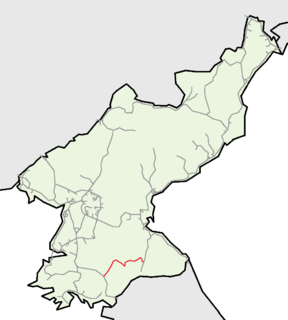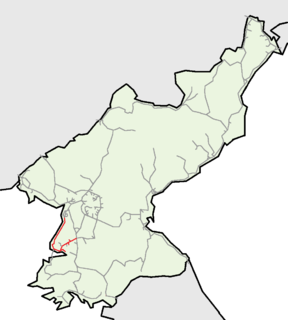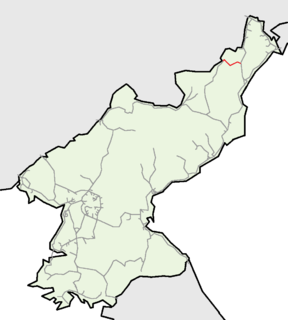
The P'yŏngbu Line is an electrified standard-gauge trunk line of the Korean State Railway running from P'yŏngyang to Kaesŏng in North Korea and further south across the DMZ to Seoul in South Korea; the name comes from the two (theoretical) termini of the line: P'yŏngyang and Pusan.

The Ch'ŏngnyŏn Ich'ŏn Line is an electrified standard-gauge secondary mainline of the Korean State Railway running from P'yŏngsan on the P'yŏngbu Line to Sep'o on the Kangwŏn Line. The 141.3 km (87.8 mi) line is the southernmost of the three east-west transversal mainlines in North Korea.

The P'yŏngnam Line is an electrified standard-gauge trunk line of the Korean State Railway in North Korea, linking P'yŏngyang with the port city of Namp'o and the hot springs at P'yŏngnam Onch'ŏn. The length of the line is 89.9 km (55.9 mi).

The Tŏkhyŏn Line is a non-electrified standard-gauge secondary line of the Korean State Railway in North P'yŏngan Province, North Korea, running from South Sinŭiju on the P'yŏngŭi Line to Tŏkhyŏn.

The Songrim Line is a partially electrified standard-gauge secondary line of the Korean State Railway in South Hwanghae Province, North Korea, running from Hwangju on the P'yŏngbu Line to Songrim.

The Taean Line is an electrified standard-gauge secondary line of the Korean State Railway in Namp'o-t'ŭkpyŏlsi, North Korea, running from Kangsŏ in Kangsŏ-guyŏk on the P'yŏngnam Line to Taean Freight Station in Taean-guyŏk.

The P'yŏngdŏk Line is an electrified standard-gauge trunk line of the Korean State Railway in North Korea running from Taedonggang Station in P'yŏngyang, where it connects to the P'yŏngbu, P'yŏngnam, P'yŏngra and P'yŏngŭi Lines, to Kujang, where it connects to the Manp'o and Ch'ŏngnyŏn P'arwŏn Lines. The total length of the line is 192.3 km (119.5 mi).

The Hambuk Line is an electrified standard-gauge trunk line of the Korean State Railway in North Korea, running from Ch'ŏngjin) on the P'yŏngra Line to Rajin, likewise on the P'yŏngra line.

The Musan Line is an electrified standard-gauge secondary trunk line of the Korean State Railway in Musan and Puryŏng counties, North Hamgyŏng Province, North Korea, running from Komusan on the Hambuk Line to Musan, where it connects to the narrow-gauge Paengmu Line. The section from Komusan to Sinch'am is double tracked.
Musan Station is a railway station in Musan-ŭp, Musan county, North Hamgyŏng province, North Korea, at the terminus of the Musan Line of the Korean State Railway. The narrow-gauge Paengmu Line from Paegam on the Paektusan Ch'ŏngnyŏn Line also terminates here.
Musan Kwangsan Station is a railway station in Musan County, North Hamgyŏng Province, North Korea. It is the terminus of the freight-only Musan Mining Line of the Korean State Railway's Musan Line.

Hoeryŏng Ch'ŏngnyŏn Station is a railway station in Hoeryŏng-si, North Hamgyŏng, North Korea, on the Hambuk Line of the Korean State Railway. It is also the starting point of the 10.6-km-long freight-only Hoeryŏng Colliery Line to Yusŏn-dong, Hoeryŏng-si.

Namyang Station is a railway station in Namyang-rodongjagu, Onsŏng county, North Hamgyŏng, North Korea, on the Hambuk Line of the Korean State Railway, and there is a bridge across the Tumen River, giving a connection to the Chinese railway network at Tumen, China via the Namyang Border Line.
Posan Station is a freight-only railway station in Posan-dong, Ch'ŏllima-guyŏk, Namp'o Special City, North Korea. It is the terminus of the Posan Line from Kangsŏ on the P'yŏngnam Line of the Korean State Railway.
The April 13 Ironworks, one of North Korea's primary metal industries, is an ironworks in Posan-dong, Ch'ŏllima-guyŏk, Namp'o.Originally opened during the Japanese colonial era, it was nationalised after the partition of Korea and has been renovated several times, in the 1960s and again in the 1980s. As of 1997 it has a production capacity of hundreds of thousands of tons of pig iron, of which all is shipped to the Ch'ŏllima Steel Complex in nearby Kangsŏn.
The Kŭmsŏng Tractor Factory, located in Kiyang-dong, Kangsŏ-guyŏk, Namp'o, is North Korea's largest manufacturer of tractors, bulldozers, and other agricultural equipment. Employing around 10,000 workers, the factory has a floor area of 142,000 m2 (1,530,000 sq ft) on a total area of 400,000 m2 (4,300,000 sq ft). Peak production capacity is 10,000 tractors per year. The factory's current products include the Ch'ŏllima 28 28 hp (21 kW), Ch'ŏllima 32 32 hp (24 kW), Ch'ŏllima 40 40 hp (30 kW), P'ungnyŏn 75 75 hp (56 kW), Sonyŏn 45 hp (34 kW) and Ch'ŏllima 2000 tractors, and the P'ungnyŏn bulldozer. As of 2017, the factory was producing the new 80-hp Ch'ŏllima 804 tractor model. Claims have been made this factory also produces TEL mobile missile platforms.
The Taean Machine Complex is machinery factory in Taean-dong, Taean-guyŏk, Namp'o Special City, North Korea producing a wide array of electric machinery for industrial and household use.
The Musan Kwangsan Line, or Musan Mining Line is a non-electrified freight-only railway line of the Korean State Railway in Musan County, North Hamgyŏng Province, North Korea, running from Ch'ŏlsong on the Musan Line to Musan Kwangsan.














